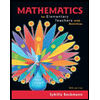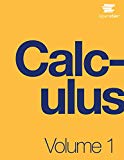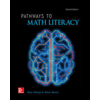
Differential Equations: An Introduction to Modern Methods and Applications
3rd Edition
ISBN: 9781118531778
Author: James R. Brannan, William E. Boyce
Publisher: WILEY
expand_more
expand_more
format_list_bulleted
Textbook Question
Chapter 7.5, Problem 6P
In each of Problems 1 through 6, an autonomous system is expressed in polar coordinates. Determine all periodic solutions, all limit cycles, and determine their stability characteristics
dr/dt=r|r−3|(r−7), dθ/dt=−1
Expert Solution & Answer
Want to see the full answer?
Check out a sample textbook solution
Students have asked these similar questions
8:38
***
TEMU
TEMU
-3
-2
7
B
2
1
& 5G. 61%
1
2
-1
Based on the graph above, determine
the amplitude, period, midline, and
equation of the function. Use f(x) as
the output.
Amplitude:
2
Period: 2
Midline:
2
☑ syntax
error: this is not an equation.
Function:
f(x) = −2 cos(πx + 2.5π) +2×
Question Help: Worked Example 1 ☑
Message instructor
Submit Question
|||
<
Let X be the relation defined on the power set of the set integers P(Z) by AXB whenever A U B is a finite set of integers. Prove whether or not X is reflexive, symmetric, antisymmetirc or transitive
8:39
***
TEMU
5G 60%
A ferris wheel is 28 meters in diameter
and boarded from a platform that is 2
meters above the ground. The six
o'clock position on the ferris wheel is
level with the loading platform. The
wheel completes 1 full revolution in 4
minutes. The function h = f(t) gives
your height in meters above the
ground t minutes after the wheel
begins to turn.
What is the amplitude?
14
meters
What is the equation of the Midline?
y = 16
What is the period?
4
meters
minutes
The equation that models the height
of the ferris wheel after t minutes is:
f(t):
=
ƒ (3) = ·−14(0) + 16
syntax error: you gave an equation,
not an expression. syntax error. Check
your variables - you might be using an
incorrect one.
How high are you off of the ground
after 3 minutes? Round your answe
the nearest meter.
|||
<
Chapter 7 Solutions
Differential Equations: An Introduction to Modern Methods and Applications
Ch. 7.1 - For each of the systems in Problems 1 through 18:...Ch. 7.1 - For each of the systems in Problems 1 through 18:...Ch. 7.1 - For each of the systems in Problems 1 through 18:...Ch. 7.1 - For each of the systems in Problemsthrough:
Find...Ch. 7.1 - For each of the systems in Problems 1 through 18:...Ch. 7.1 - For each of the systems in Problems 1 through 18:...Ch. 7.1 - For each of the systems in Problemsthrough:
Find...Ch. 7.1 - For each of the systems in Problems 1 through 18:...Ch. 7.1 - For each of the systems in Problemsthrough:
Find...Ch. 7.1 - For each of the systems in Problems 1 through 18:...
Ch. 7.1 - For each of the systems in Problems 1 through 18:...Ch. 7.1 - For each of the systems in Problems 1 through 18:...Ch. 7.1 - For each of the systems in Problems 1 through 18:...Ch. 7.1 - For each of the systems in Problems 1 through 18:...Ch. 7.1 - For each of the systems in Problemsthrough:
Find...Ch. 7.1 - For each of the systems in Problems 1 through 18:...Ch. 7.1 - For each of the systems in Problems 1 through 18:...Ch. 7.1 - For each of the systems in Problemsthrough:
Find...Ch. 7.1 -
Consider the equations of motion of an undamped...Ch. 7.1 - The motion of a certain undamped pendulum is...Ch. 7.1 - Consider the pendulum equations dxdt=y,dydt=6sinx....Ch. 7.1 - Prob. 22PCh. 7.1 - Given that x=(t),y=(t) is a solution of the...Ch. 7.1 - Prove that, for the system...Ch. 7.1 - Prove that if a trajectory starts at a noncritical...Ch. 7.1 - Assuming that the trajectory corresponding to a...Ch. 7.2 - In each of Problems 1 through 20: (a) Determine...Ch. 7.2 - In each of Problems through
Determine all...Ch. 7.2 - In each of Problems 1 through 20: (a) Determine...Ch. 7.2 - In each of Problems 1 through 20: (a) Determine...Ch. 7.2 - In each of Problems through
Determine all...Ch. 7.2 - In each of Problems 1 through 20: (a) Determine...Ch. 7.2 - In each of Problems 1 through 20: (a) Determine...Ch. 7.2 - In each of Problems 1 through 20: (a) Determine...Ch. 7.2 - In each of Problems through
Determine all...Ch. 7.2 - In each of Problems through
Determine all...Ch. 7.2 - In each of Problems through
Determine all...Ch. 7.2 - In each of Problems 1 through 20: (a) Determine...Ch. 7.2 - In each of Problems through
Determine all...Ch. 7.2 - In each of Problems through
Determine all...Ch. 7.2 - In each of Problems 1 through 20: (a) Determine...Ch. 7.2 - In each of Problems 1 through 20: (a) Determine...Ch. 7.2 - In each of Problems 1 through 20: (a) Determine...Ch. 7.2 - In each of Problems 1 through 20: (a) Determine...Ch. 7.2 - In each of Problems 1 through 20: (a) Determine...Ch. 7.2 - In each of Problems through
Determine all...Ch. 7.2 - Consider the autonomous system dxdt=y,dydt=x+2x3....Ch. 7.2 - Consider the autonomous system
...Ch. 7.2 - The equations of motion of a certain nonlinear...Ch. 7.2 - Theorem 7.2.2 provides no information about the...Ch. 7.2 - In this problem, we show how small changes in the...Ch. 7.2 - In this problem, we show how small changes in the...Ch. 7.2 - A generalization of the damped pendulum equation...Ch. 7.3 - Each of Problems 1 through 6 can be interpreted as...Ch. 7.3 - Each of Problems 1 through 6 can be interpreted as...Ch. 7.3 - Each of Problems 1 through 6 can be interpreted as...Ch. 7.3 - Each of Problems 1 through 6 can be interpreted as...Ch. 7.3 - Each of Problems 1 through 6 can be interpreted as...Ch. 7.3 - Each of Problems 1 through 6 can be interpreted as...Ch. 7.3 - Show that (1X+2Y)24(1212)XY=(1X2Y)2+412XY. Hence...Ch. 7.3 - Consider the system (2) in the text, and assume...Ch. 7.3 - Consider the system (3) in Example 1 of the text....Ch. 7.3 - The system x=yy=yx(x0.15)(x3) Results from an...Ch. 7.3 - Bifurcation points. Consider the system...Ch. 7.3 - Bifurcation points. Consider the system
Where is...Ch. 7.3 - Bifurcation points. Consider the system
Where is...Ch. 7.3 - Bifurcation points. Consider the system
Where is...Ch. 7.3 - In each of Problem 15 and 16: a) Find the critical...Ch. 7.3 - In each of Problem 15 and 16:
Find the critical...Ch. 7.3 - Suppose that a certain pair of competing species...Ch. 7.4 - Each of Problems 1 through 5 can be interpreted as...Ch. 7.4 - Each of Problems 1 through 5 can be interpreted as...Ch. 7.4 - Each of Problems 1 through 5 can be interpreted as...Ch. 7.4 - Each of Problems 1 through 5 can be interpreted as...Ch. 7.4 - Each of Problems 1 through 5 can be interpreted as...Ch. 7.4 - In this problem, we examine the phase difference...Ch. 7.4 - a) Find the ratio of the amplitudes of the...Ch. 7.4 -
Find the period of the oscillations of the prey...Ch. 7.4 - Consider the system
Where and are positive...Ch. 7.4 - The average size of the prey and predator...Ch. 7.4 - In Problems 11 and 12, we consider the effect of...Ch. 7.4 - In Problems 11 and 12, we consider the effect of...Ch. 7.4 - In the Lotka-Volterra equations, the interaction...Ch. 7.4 - Harvesting in a Predator-Prey Relationship. In a...Ch. 7.4 - Harvesting in a Predator-Prey Relationship. In a...Ch. 7.4 - Harvesting in a Predator-Prey Relationship. In a...Ch. 7.5 - In each of Problems through , an autonomous...Ch. 7.5 - In each of Problems 1 through 6, an autonomous...Ch. 7.5 - In each of Problems 1 through 6, an autonomous...Ch. 7.5 - In each of Problems 1 through 6, an autonomous...Ch. 7.5 - In each of Problems through , an autonomous...Ch. 7.5 - In each of Problems 1 through 6, an autonomous...Ch. 7.5 - If x=rcos,y=rsin, show that...Ch. 7.5 - (a) Show that the system has periodic solutions...Ch. 7.5 - Determine the periodic solutions, if any, of the...Ch. 7.5 - Using Theorem, show that the linear autonomous...Ch. 7.5 - In each of Problems 11 and 12, show that the given...Ch. 7.5 - In each of Problems and , show that the given...Ch. 7.5 - Prob. 13PCh. 7.5 -
By examining the graphs of vs. in Figures , , ...Ch. 7.5 - The equation u(113u2)u+u=0 Is often called the...Ch. 7.5 - Consider the system of equations...Ch. 7.5 - Consider the van der Pol system x=y,y=x+(1x2)y,...Ch. 7.5 - Problems 18 and 19 extend the consideration of the...Ch. 7.5 - Problems 18 and 19 extend the consideration of the...Ch. 7.5 - There are certain chemical reactions in which the...Ch. 7.5 - The system
Is a special case of the...Ch. 7.6 - Problems through ask you to fill in some of the...Ch. 7.6 - Problems through ask you to fill in some of the...Ch. 7.6 -
Ch. 7.6 - Consider the ellipsoid
.
Calculate
along...Ch. 7.6 - In each of Problems 5 through 7, carry out the...Ch. 7.6 - In each of Problems 5 through 7, carry out the...Ch. 7.6 - In each of Problems 5 through 7, carry out the...Ch. 7.6 - For certain intervals, or windows, the Lorenz...Ch. 7.6 - Now consider values of r slightly larger than...Ch. 7.P1 - Assume that , that is, the total size of the...Ch. 7.P1 - The triangular region in the SI-plane is depicted...Ch. 7.P1 - If epidemics are identified with solution...Ch. 7.P1 - Find an equation of the form satisfied by the...Ch. 7.P1 - In the SIR system (1), describe qualitatively the...Ch. 7.P1 - Vaccinated individual are protected from acquiring...Ch. 7.P1 - Use the equation to reduce the SIRS model (3) to...Ch. 7.P2 - Consider again the system
(i)
Which...Ch. 7.P2 - Consider the system dxdt=x(1xy),dydt=y(0.80.6yx),...Ch. 7.P2 - Consider the system (i) in Problem 1, and assume...Ch. 7.P2 - Aconstant-yield model, applied to species x,...Ch. 7.P3 - a) Show that there are no critical points when...Ch. 7.P3 - a) Let c=1.3. Find the critical points and the...Ch. 7.P3 - The limit cycle found in Problem 2 comes into...Ch. 7.P3 -
Let. Find the critical points and the...Ch. 7.P3 -
Let. Find the critical points and the...
Additional Math Textbook Solutions
Find more solutions based on key concepts
Solve each formula for the given letter . [2.3] What percent of 60 is 42? [2.4]
Elementary and Intermediate Algebra: Concepts and Applications (7th Edition)
A pair of dice is rolled until a sum of either 5 or 7 appears. Find the probability that a 5 occurs first. Hint...
A First Course in Probability (10th Edition)
For a population containing N=902 individual, what code number would you assign for a. the first person on the ...
Basic Business Statistics, Student Value Edition
The equivalent expression of x(y+z) by using the commutative property.
Calculus for Business, Economics, Life Sciences, and Social Sciences (14th Edition)
NOTE: Write your answers using interval notation when appropriate.
CHECKING ANALYTIC SKILLS Fill in each blank ...
Graphical Approach To College Algebra
To find the four solution of equation and write the solution in ordered pair
Pre-Algebra Student Edition
Knowledge Booster
Learn more about
Need a deep-dive on the concept behind this application? Look no further. Learn more about this topic, subject and related others by exploring similar questions and additional content below.Similar questions
- can you solve this question step by step pleasearrow_forwardS cosx dx sin -3/ (x) Xarrow_forwardUsing the toddler data table in Question 1, describe the toddlers in the sample with joint probabilities only. (300) B(K)-00+300 501 30 smot dbabib (oor de leng 001-009:(00s) 200, yoogie Fox (D) ed to diman edarrow_forward
- Right-Handed Left-Handed 24 Gender Males 4 Females 2 12arrow_forwardappropriate probabilities. 19 Using the data from Table 17-1, are gender and political party independent for this group? nis cow sib signia si Falows grillor le pussarrow_forward11 Using the same toddler data, describe the toddlers with marginal probabilities only. BAY bit of benoliesmas (89 abje' jook stages of te cojota ing ou an out of to cojota ovig ber el ba 3+4=029arrow_forward
- 21 Using the data from the table in Question 1, does the dominant hand differ for male toddlers versus female toddlers? (In other words, are these two events dependent?)arrow_forwardop In a two-way table with variables A and B, does P(A|B) + P(A|B) = 1? பே 69 6 work as m 3 atavs ow to portabagabat sot gaisarrow_forwardIn a two-way table with variables A and B, does P(A|B)+P(A|B)=1? dsins/Ispino936) 1 durab ALED a to gilidadost Earrow_forward
- preference are dependent (you even have to look at the males). Using the bumper sticker data in the first example problem in this chapter, are car age and number of bumper stickers related (In other words, are these two events dependent?) d insbusqabni oss agit ads bms gliw woy tadi validadong ada 15W wex s m ad ow MP gliw Boy 1st yilidadong at al terW .d Shsed smo viaxe 5X9 of pe 012 from 12 or to HOM qose Aunt swam to prepants M&arrow_forward23 வ dous biops Which marginal probabilities that you find in a two-way table should sum to 1? 著arrow_forwardUsing the toddler data from the table in Question 1 and appropriate probability notation, do the following: a. Compare the right-handed female and male toddlers in the sample, using condi- tional probabilities (only). b. Compare the right-handed toddlers asid in the sample, using conditional probabilities (only).dependent abni sis & bas bax bensqged snavs med) galworl andarrow_forward
arrow_back_ios
SEE MORE QUESTIONS
arrow_forward_ios
Recommended textbooks for you
 Discrete Mathematics and Its Applications ( 8th I...MathISBN:9781259676512Author:Kenneth H RosenPublisher:McGraw-Hill Education
Discrete Mathematics and Its Applications ( 8th I...MathISBN:9781259676512Author:Kenneth H RosenPublisher:McGraw-Hill Education Mathematics for Elementary Teachers with Activiti...MathISBN:9780134392790Author:Beckmann, SybillaPublisher:PEARSON
Mathematics for Elementary Teachers with Activiti...MathISBN:9780134392790Author:Beckmann, SybillaPublisher:PEARSON
 Thinking Mathematically (7th Edition)MathISBN:9780134683713Author:Robert F. BlitzerPublisher:PEARSON
Thinking Mathematically (7th Edition)MathISBN:9780134683713Author:Robert F. BlitzerPublisher:PEARSON Discrete Mathematics With ApplicationsMathISBN:9781337694193Author:EPP, Susanna S.Publisher:Cengage Learning,
Discrete Mathematics With ApplicationsMathISBN:9781337694193Author:EPP, Susanna S.Publisher:Cengage Learning, Pathways To Math Literacy (looseleaf)MathISBN:9781259985607Author:David Sobecki Professor, Brian A. MercerPublisher:McGraw-Hill Education
Pathways To Math Literacy (looseleaf)MathISBN:9781259985607Author:David Sobecki Professor, Brian A. MercerPublisher:McGraw-Hill Education

Discrete Mathematics and Its Applications ( 8th I...
Math
ISBN:9781259676512
Author:Kenneth H Rosen
Publisher:McGraw-Hill Education

Mathematics for Elementary Teachers with Activiti...
Math
ISBN:9780134392790
Author:Beckmann, Sybilla
Publisher:PEARSON


Thinking Mathematically (7th Edition)
Math
ISBN:9780134683713
Author:Robert F. Blitzer
Publisher:PEARSON

Discrete Mathematics With Applications
Math
ISBN:9781337694193
Author:EPP, Susanna S.
Publisher:Cengage Learning,

Pathways To Math Literacy (looseleaf)
Math
ISBN:9781259985607
Author:David Sobecki Professor, Brian A. Mercer
Publisher:McGraw-Hill Education
But what is the Fourier Transform? A visual introduction.; Author: 3Blue1Brown;https://www.youtube.com/watch?v=spUNpyF58BY;License: Standard YouTube License, CC-BY